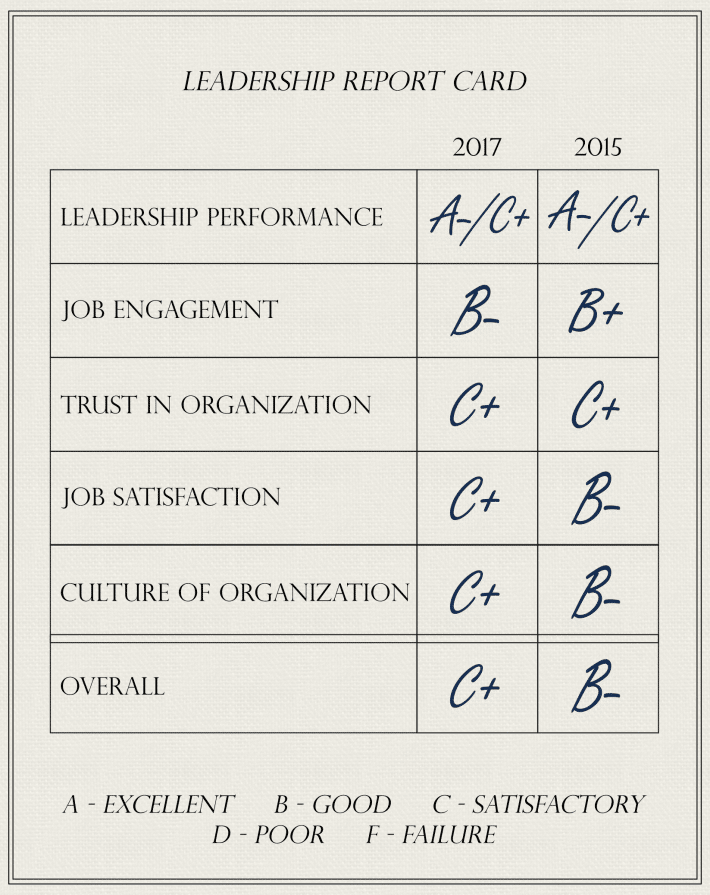In 2015, the Plank Center for Leadership in Public Relations and comms-focused exec search firm Heyman Associates produced its first Report Card on PR Leaders. Leaders earned passing grades for the five areas examined—leadership performance, job engagement, trust in the organization, work culture and job satisfaction—but crucial gaps highlighted areas for improvement.
Nearly 1,200 PR leaders and professionals in the U.S. completed the same survey in 2017. Grades for leadership performance and trust were unchanged, but slipped for work culture, job engagement and job satisfaction. The overall grade for PR leaders fell from B- to C+. Gaps between leaders’ and employees’ perceptions of the five areas remained wide, while gender differences deepened.
Women in public relations were significantly less engaged, less satisfied with their jobs, less confident in their work cultures, less trusting of their organizations and more critical of top leaders than men. Previous concerns about two-way communication, shared decision-making and diversity were again underscored by men and women.
“Social tensions in our world today have likely exacerbated these issues. We need to be bigger leaders to close these gaps,” said Bill Heyman, CEO and president of Heyman Associates, co-sponsor of the study, in a news release.

Here’s how this year’s grades panned out:
Performance of the top leader: (A-/C+)
Leaders’ and their employees’ perceptions of the top leader’s performance again differed sharply—leaders gave themselves an “A-,” while followers gave them a “C+.” The grades were virtually identical to those in 2015. Leaders received higher marks for ethical orientation and involvement in strategic decision-making but earned lower grades for their vision, relationship-building skills and team leadership capabilities. Men ranked top-leader performance significantly higher than women.
“This gap doesn’t necessarily mean leaders are ineffective,” said co-investigator Juan Meng, Ph.D., of the University of Georgia Crisis Communication Coalition, in the release. “Employees may be upset about other issues in their lives or unhappy with a recent assignment. But closing the gap is important because leaders influence all other issues in our study.”
Job engagement: (B-)
The grade fell from a “B+” in 2015 because fewer professionals were engaged. In 2017, 57.2 percent of respondents were engaged (vs. 59.7 percent in 2015); 35.9 percent were not engaged (vs 34.4 percent); and 6.8 percent were actively disengaged (vs. 6.0 percent). Many more top leaders were more engaged (71.7 percent) than others (50.1 percent).
The decline in engagement is largely tied to lower engagement levels among women. In 2015, more women (61.3 percent) were engaged than men (57.9 percent). However, in 2017 more men (62.1 percent) were engaged than women (52.9 percent). In the non-top leader group, less than half of women were engaged (46.4 percent), and nearly one in ten (9.7 percent) was actively disengaged.
Job engagement of PR professionals: 2017 vs. 2015
| Engaged | Not Engaged | Actively Disengaged | ||||
| Demographic | 2017 | 2015 | 2017 | 2015 | 2017 | 2015 |
| Total respondents | 57.2% | 59.7% | 35.9% | 34.4% | 6.8% | 6.0% |
| Male professionals | 62.1% | 57.9% | 32.5% | 35.2% | 5.4% | 6.8% |
| Female professionals | 52.9% | 61.3% | 39.0% | 33.6% | 8.1% | 5.1% |
| Top leaders | 71.7% | 72.3% | 24.5% | 24.5% | 3.8% | 3.2% |
| Non-top leaders (all others) | 50.1% | 54.2% | 41.6% | 38.6% | 8.3% | 7.2% |
| Males (non-top leaders) | 54.7% | 52.7% | 38.7% | 39.6% | 6.6% | 7.6% |
| Females (non-top leaders) | 46.4% | 55.5% | 43.9% | 37.7% | 9.7% | 6.8% |
Trust in the organization: (C+)
Trust in the organization again received the lowest grade and was an issue at all levels. Professionals trusted their organization’s capabilities to compete successfully and achieve its goals, but expressed less trust in their organizations to keep promises and to be concerned about employees when making important decisions. Women were much less trusting of their organizations, especially regarding the value of their concerns and opinions in decision making.
Job satisfaction: (C+)
This grade dropped from a “B-” in 2015 as the percentage of those satisfied or very satisfied with their job declined from 66.7 percent to 61.9 percent. The percentage of those dissatisfied or very dissatisfied with their jobs rose from 22.1 percent to 24.1 percent, while those neither satisfied nor dissatisfied rose from 11.2 percent to 14.0 percent. Biggest declines were among top leaders and women. More men (65.9 percent) were satisfied or very satisfied with their job than women (58.3 percent). Agency PR professionals were most satisfied compared to those working in companies or nonprofits.
Organizational culture: (C+)
Culture refers to the internal environment, processes and structures that help or impede communication practices. This grade fell from a “B-” in 2015. The CEO’s understanding and valuing of public relations was rated highly, while that of other functional leaders was rated lower. Shared decision-making practices and the presence of two-way communications and diversity were graded far lower. Top leaders rated cultural factors higher than those at other levels. Women rated all cultural factors lower than men—and shared decision-making power a great deal lower. Agency professionals rated culture highest among organizational types.
Three crucial gaps need attention
The perceptions of top leaders and their employees. Top leaders rated their performance and all other areas significantly higher than their employees. Things look different—and far better—at the top. Leaders may often rate their performance higher than their employees, but statistically the gap is Grand-Canyon sized. Leaders at all levels can benefit from relying less on the transmission mode and more on the reception mode when communicating with employees. Solutions include: 1) increased power sharing, or leader empowering behaviors, 2) strengthened two-way communications, and 3) enhanced interpersonal skills in team work, such as active listening and conflict management skills.
Existing culture and a culture for communication. Issues like the lack of two-way communication, limited power sharing and diversity concerns point to differences between existing cultures and a rich communication system sometimes referred to as a culture for communication. Such a culture is characterized by: 1) an open communication system where information is widely shared; 2) dialogue, discussion and learning; 3) the use of two-way and multiple channels; 4) a climate in which employees can speak up without fear of retribution; and 5) leaders who support and value public relations and internal communications. Culture exerts a strong influence on trust.
Perceptions of women and men in the profession. The gender gap deepened in the 2017 survey in every subject area. Women’s perceptions of their lack of shared power in decision making, insufficient two-way communication, and de-valuing of their opinions are reflected in lower levels of trust in the organization and its culture, less confidence in leaders and declining job engagement.
Progress in diversity in public relations in many senses remains painfully slow. For women in the survey, it appears that being successful in the field is still challenging; the pay gap is real; the opportunity gap is real; and the being-heard-and-respected-gap is real. These gaps require attention and action, and the power to act resides in the minds, hearts and hands of current leaders at all levels in the profession.
“The purpose of this biennial report is to assess leadership in PR and identify enrichment opportunities,” said Bruce K. Berger, Ph.D., co-investigator and research director of the Plank Center at the University of Alabama. “If we identify the gaps and work to close them, we strengthen our profession’s leadership—a crucial strategic asset. The 2017 Report Card underscores the continuing gaps and the need to act.”
A full report of the research is available on the Plank Center site.
A 39-question survey was distributed online to about 31,000 PR leaders and managers, and 1,185 completed the survey. This response provides a 99% confidence level (+/- 5%) the results represent the larger population of surveyed professionals. Most participants were senior leaders and managers: 75% of the 1,185 respondents were the #1 or #2 communication professional in their organization, and 92% had 11 years of experience or more. More women (631 or 53.3%) than men (554 or 46.7%) completed the survey. The majority of participants worked in public (453 or 38.2%) or private (189 or 15.9%) corporations, followed by nonprofits (357 or 30.1%), communication agencies (157 or 13.2%) and self-employed or others (29 or 2.5%).



